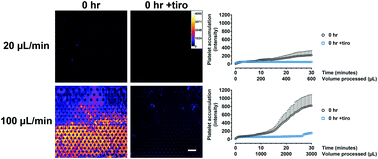Our official English website, www.x-mol.net, welcomes your
feedback! (Note: you will need to create a separate account there.)
Anti-thrombotic strategies for microfluidic blood processing
Lab on a Chip ( IF 6.1 ) Pub Date : 2018-06-14 00:00:00 , DOI: 10.1039/c8lc00035b Keith H. K. Wong 1, 2, 3, 4, 5 , Jon F. Edd 1, 2, 3, 4, 5 , Shannon N. Tessier 1, 2, 3, 4, 5 , Will D. Moyo 1, 2, 3, 4, 5 , Baris R. Mutlu 1, 2, 3, 4, 5 , Lauren D. Bookstaver 1, 2, 3, 4, 5 , Kathleen L. Miller 1, 2, 3, 4, 5 , Stefan Herrara 1, 2, 3, 4, 5 , Shannon L. Stott 1, 2, 3, 4, 5 , Mehmet Toner 1, 2, 3, 4, 5
Lab on a Chip ( IF 6.1 ) Pub Date : 2018-06-14 00:00:00 , DOI: 10.1039/c8lc00035b Keith H. K. Wong 1, 2, 3, 4, 5 , Jon F. Edd 1, 2, 3, 4, 5 , Shannon N. Tessier 1, 2, 3, 4, 5 , Will D. Moyo 1, 2, 3, 4, 5 , Baris R. Mutlu 1, 2, 3, 4, 5 , Lauren D. Bookstaver 1, 2, 3, 4, 5 , Kathleen L. Miller 1, 2, 3, 4, 5 , Stefan Herrara 1, 2, 3, 4, 5 , Shannon L. Stott 1, 2, 3, 4, 5 , Mehmet Toner 1, 2, 3, 4, 5
Affiliation

|
The redundant mechanisms involved in blood coagulation are crucial for rapid hemostasis. Yet they also create challenges in blood processing in medical devices and lab-on-a-chip systems. In this work, we investigate the effects of both shear stress and hypothermic blood storage on thrombus formation in microfluidic processing. For fresh blood, thrombosis occurs only at high shear, and the glycoprotein IIb/IIIa inhibitor tirofiban is highly effective in preventing thrombus formation. Blood storage generally activates platelets and primes them towards thrombosis via multiple mechanisms. Thrombus formation of stored blood at low shear can be adequately inhibited by glycoprotein IIb/IIIa inhibitors. At high shear, von Willebrand factor-mediated thrombosis contributes significantly and requires additional treatments with thiol-containing antioxidants—such as N acetylcysteine and reduced glutathione—that interfere with von Willebrand factor polymerization. We further demonstrate the effectiveness of these anti-thrombotic strategies in microfluidic devices made of cyclic olefin copolymer, a popular material used in the healthcare industry. This work identifies effective anti-thrombotic strategies that are applicable in a wide range of blood- and organ-on-a-chip applications.
中文翻译:

微流血处理的抗血栓策略
涉及凝血的冗余机制对于快速止血至关重要。然而,它们也给医疗设备和芯片实验室系统的血液处理带来了挑战。在这项工作中,我们研究了微流处理中剪切应力和低温储血对血栓形成的影响。对于新鲜血液,血栓形成仅在高剪切下发生,并且糖蛋白IIb / IIIa抑制剂替罗非班在预防血栓形成方面非常有效。血液储存通常会激活血小板,并通过以下步骤引发血小板血栓形成多种机制。糖蛋白IIb / IIIa抑制剂可充分抑制低剪切下的血栓形成。在高剪切下,von Willebrand因子介导的血栓形成显着起作用,并需要用含硫醇的抗氧化剂(例如N乙酰半胱氨酸和还原型谷胱甘肽)进行额外治疗,这会干扰von Willebrand因子聚合。我们进一步证明了这些抗血栓形成策略在由环烯烃共聚物(一种在医疗保健行业中广泛使用的材料)制成的微流体装置中的有效性。这项工作确定了有效的抗血栓形成策略,这些策略适用于广泛的血液和单片器官应用。
更新日期:2018-06-14
中文翻译:

微流血处理的抗血栓策略
涉及凝血的冗余机制对于快速止血至关重要。然而,它们也给医疗设备和芯片实验室系统的血液处理带来了挑战。在这项工作中,我们研究了微流处理中剪切应力和低温储血对血栓形成的影响。对于新鲜血液,血栓形成仅在高剪切下发生,并且糖蛋白IIb / IIIa抑制剂替罗非班在预防血栓形成方面非常有效。血液储存通常会激活血小板,并通过以下步骤引发血小板血栓形成多种机制。糖蛋白IIb / IIIa抑制剂可充分抑制低剪切下的血栓形成。在高剪切下,von Willebrand因子介导的血栓形成显着起作用,并需要用含硫醇的抗氧化剂(例如N乙酰半胱氨酸和还原型谷胱甘肽)进行额外治疗,这会干扰von Willebrand因子聚合。我们进一步证明了这些抗血栓形成策略在由环烯烃共聚物(一种在医疗保健行业中广泛使用的材料)制成的微流体装置中的有效性。这项工作确定了有效的抗血栓形成策略,这些策略适用于广泛的血液和单片器官应用。











































 京公网安备 11010802027423号
京公网安备 11010802027423号